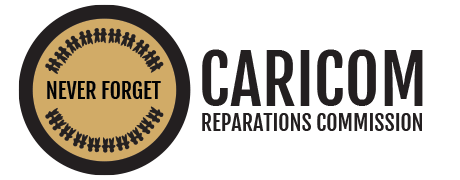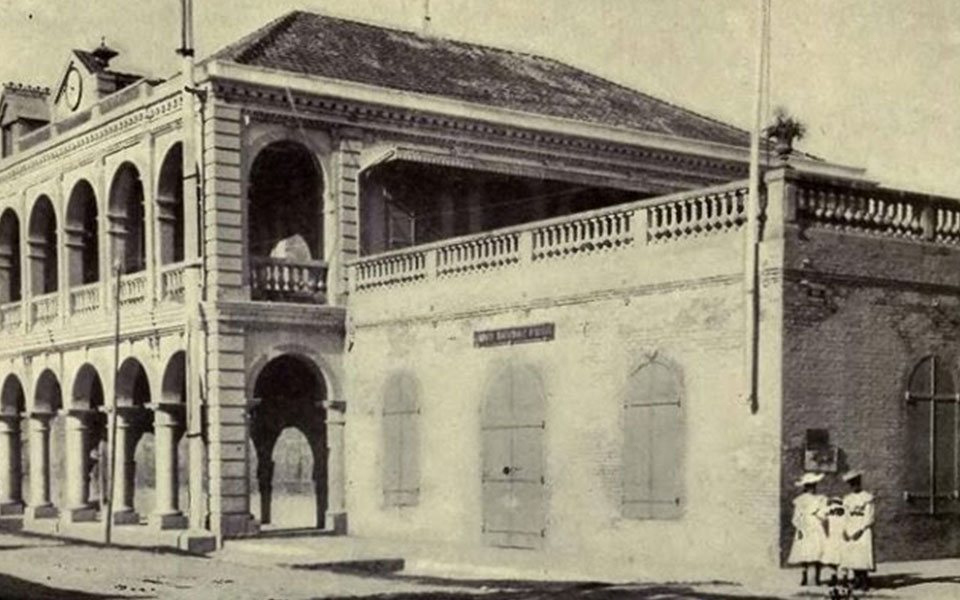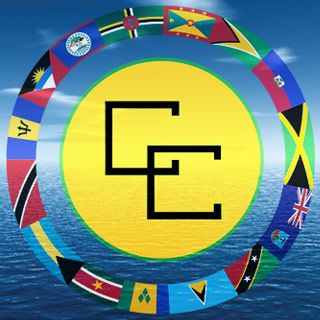The expansion of banks such as Citigroup into Cuba, Haiti, and beyond reveal a story of capitalism built on blood, labor, and racial lines.
by Peter James Hudson
Scrubbed from the pages of glossy coffeetable books, the history of U.S. imperialism can be found in the archives of Wall Street’s oldest, largest, and most powerful institutions. A deep dive into the vaults and ledgers of banking houses such as Citigroup, Inc., and J. P. Morgan Chase and Co. reveals a story of capitalism and empire whose narrative is not of morally pure and inspiring economic growth, technological innovation, market expansion, and shareholder accumulation, but rather of blood and labor, stolen sovereignty and pilfered resources, military occupation and monetary control. Sugar comingles with blood, chain gangs cross spur lines, and the magical abstractions of finance are found vulgarized in the base manifestations of racial capitalism.
The Caribbean archipelago was ground zero for U.S. imperial banking
This history of bankers and empire is also a Caribbean history. The Caribbean archipelago was ground zero for U.S. imperial banking. Wall Street’s first experiments in internationalism occurred in Cuba, Haiti, Panama, Puerto Rico, the Dominican Republic, and Nicaragua, often with disastrous results—for those countries and colonies, and often for the imperial banks themselves. Yet where there was expansion, there was also pushback. The internationalization of Wall Street was met with local resistance, refusal and revolt. And just as the history of imperialism has been excised from popular narratives, so too has this history of Caribbean anti-imperialism and autonomy.
The history of imperial banking and racial capitalism begins at the end of the nineteenth century, at the historical horizon where the project of U.S. settler colonialism that spurred the financing of the West became the enterprise of U.S. territorial colonialism in the Caribbean and Asia.
Buoyed by unprecedented wealth and boosted by the expansionist jingoism following the victory over Spain in the Caribbean and the Pacific, New York City’s bankers and merchants believed that the organization of an imperial banking system—one that could compete with Europe’s long-established institutions—was critical to the global rise of the city and to the consolidation of Wall Street’s position in international finance, trade, and commerce. With these ambitions, bankers and business-people set their sights on asserting control over the trade and finance of the Americas. They sought to control local central banks, establish U.S. branch banks, take over commodity financing, reorganize monetary systems on a dollar basis, and refinance European-funded sovereign debt.
This project of internationalization was explicitly encouraged and supported by the U.S. government. The war and state departments required fiscal agencies to support the infrastructure of U.S. colonialism, and financial institutions were an important conduit of colonial policy and financial and commercial diplomacy. Bankers, however, needed little prodding to move overseas, extending their influence into the sugar plantations, railroads, and financial systems of Haiti, Cuba, Santo Domingo, and Nicaragua. The U.S. state made both implicit and explicit assurances that it would intervene should local conditions turn against U.S. business interests or disrupt the payments of interest or customs revenue.
Founded in 1812, City Bank—the precursor to today’s Citigroup—emerged as the largest and most important imperial financier in the United States
At the center of this story was the National City Bank of New York, the precursor to today’s Citigroup, Inc. Founded in 1812, it emerged as the largest and most important imperial financier in the United States. Through most of the nineteenth century, it was a powerful but staid merchant bank whose cautious lending and massive cash reserves helped it ride the nation’s economic roils. It took on a more aggressive, entrepreneurial, and activist strategy for expansion and growth under James Stillman and Frank A. Vanderlip, who carried it into the twentieth century.
Stillman and Vanderlip transformed City Bank from a merchant bank into a modern financial department store—creating a new managerial structure, expanding into new financial markets, and exploring the possibilities of foreign expansion and international banking. The most important theater of internationalization was the “American Mediterranean,” as one City Banker described the countries and colonies ringing the Caribbean Sea and the Gulf of Mexico. There, the bank experimented with the issuance of sovereign debt, the financing of international trade, the funding of industrial infrastructure, and the organization of regional state banks and currency systems. Beginning in 1914, it also made the Caribbean the centerpiece of the largest foreign branch bank system of any U.S. banking house, with Cuba the jewel in its crown.
Law was critical to City Bank’s internationalization and expansion. As part of its efforts, City Bank hammered away at the banking regulations shackling its activities and pushed for regulatory reform while creating new subsidiary organizations that could navigate the complex regulatory geographies of international finance or simply evade existing legal constraint. Wall Street lawyer John Sterling, of Shearman and Sterling, worked closely with Stillman and Vanderlip, while other firms worked to devise the colonial methods by which the imperial banks operated.
Race was central to City Bank’s work, too. In its encounters with the nations and colonies of the Caribbean and Latin America, Wall Street helped reorder those economies along racial lines, exporting the U.S. racist imaginaries in which Wall Street was embedded and through which it functioned. When conducting business in the Caribbean, U.S. bankers understood people of color—whether Africans or indigenous peoples—through the same racist lenses they viewed them through at home. White representations of African Americans, in particular, were exported to the West Indies and inscribed in a vast and diffuse archive of pamphlets, reports, circulars, press releases, prospectuses, and journal articles produced by Wall Street about the Caribbean and Latin America. At the same time, in their dispatches back to the United States, bankers translated the Caribbean to U.S. businesspeople, investors, and the general public. In some cases they debunked stereotypes as a means to encourage investment. In others they replicated and reconstituted racial stereotypes in order to further the expansion of white supremacist control of the region—with returns to investment found not in the extraction of capital values, but in the ledger of white racial dominance.
Wall Street helped reorder the economies of the Caribbean and Latin America along racial lines
One example of this practice can be found in City Bank vice president John H. Allen, one of the new slate of managers and vice presidents appointed by Vanderlip as part of the bank’s modernization of its bureaucracy. Allen aided the bank’s expansion into Cuba and Argentina and was the manager of the City Bank–controlled Banque Nationale de la République d’Haiti in the 1910s. In the City Bank’s foreign trade journal The Americas, Allen evoked a picture of Haiti that would have been recognizable to white U.S. audiences but for its tropical setting. “Cock-fighting and card playing,” Allen asserted, “are the national pastimes, and these, together with a supply of Haitian rum, are all that is necessary for a Haitian citizen’s perfect day.” He claimed that during his visits to Haiti, he found that “humorous incidents were of almost daily occurrences.” For Allen, such incidents “showed the naivete and also the restricted mentality of the people, which latter was plainly noticeable even among the more highly educated.”
These anecdotes did not exist in a vacuum. They were not an incidental cultural membrane stretched over the inner workings of banking, racial capitalism, and imperialism. Instead they contributed to the fundamental ideological and cultural rationales that made the Caribbean the target of Wall Street’s imperial aims, and at the same time helped fashion the terms through which the Caribbean was encountered. These representations were underwritten by both direct and indirect forms of violence: by coercive diplomacy, military force, and labor impressment, as well as by the terms and conditions of credit and debt, the imbalanced application of law and legal regulation, and the imposition of modern forms of post-emancipation financial governance.
Indeed, Allen himself was deeply involved with the decision to send U.S. Marines to Haiti in 1915 in what would become a nineteen-year military occupation. City Bank had been interested in Haitian investments since about 1910, and Vanderlip sought to use some initial railway and dock investments as a springboard to control the republic’s financial system. Haiti’s internal political conflicts, fueled in part by outside agitation and interference from both U.S. and European speculators, created disastrous terms for business. In response, City Bank’s Roger L. Farnham, who viewed the Haitian people as “nothing but grown-up children” who required the paternalistic guidance of a stronger power, drafted a document arguing for U.S. military intervention to stabilize the country and protect U.S. financial and commercial interests.
The Farnham plan, as it was dubbed, was realized in 1915, when Marines landed to restore order following the assassination of Haitian president Vilbrun Guillaume Sam. The occupation provided the platform for City Bank’s takeover of the Banque Nationale while making City Bank’s imposition of a $30 million loan to the Haitian government almost risk free. Vanderlip described Haiti as “a small but profitable piece of business” for City Bank. But such profits came at a cost: the suppression of a series of peasant insurgencies that left thousands of Haitians dead and dozens of villages burned. Hundreds of Haitians were jailed or forced to work on chain gangs, serving as a reminder to many Haitians of the days of slavery.
City Bank was not the only U.S. financial institution charting an imperial turn. It was joined by its neighbors on Wall Street, sometimes as collaborators involved in a collective project to consolidate the financial realms of the U.S. imperium, sometimes as rivals embroiled in bitter competition.
Chase Manhattan Bank, for instance, made an aggressive push to displace City Bank in Panama while fighting City Bank for pride of place in the financing of the dictatorship of Gerardo Machado y Morales in Cuba. Meanwhile, Wall Street’s unincorporated and private investment banks, including J. P. Morgan and Co., Speyer and Co., and Kuhn, Loeb and Co., began floating the public debt of Caribbean, Latin American, and Asian countries, states, and municipalities and financing railroad and port projects. These private bankers had initially grown in prominence by using their strong European networks and their close family ties as the conduit to market U.S. government bonds and corporate securities across the Atlantic. Now, increasingly, they sold Caribbean and Latin American debt in the United States.
The domestic crisis of finance capitalism in the United States became a crisis of racial capitalism in the Caribbean
Private bankers came to play an important role in the policy of “dollar diplomacy” initiated by President William Howard Taft and his secretary of state, Philander Knox, in the 1910s. In the attempt to displace European influence and extend U.S. capitalism in the Caribbean— which purported to replace military intervention with financial diplomacy—private bankers worked with financial experts and local governments to refund sovereign debt, reorganize customs collection and currency systems, and organize nominally national government banks. The disordered global financial and economic conditions unleashed by World War I accelerated the internationalization of Wall Street and intensified the relationship between banking, bankers, and imperialism.
But the expansion, and this initial experiment in imperial banking, was short lived. The sharp economic crisis following the postwar commodity boom forced a brief retreat from internationalization, prompting many Wall Street institutions, including City Bank, to rethink their strategies for expansion. Meanwhile the local banking sector in Cuba was completely destroyed. Of course, by the end of the 1920s, another crisis had occurred; the concussions of the October 1929 stock market crash were felt not only domestically, but throughout the international branch and subsidiary networks of Wall Street—perhaps most acutely in the Caribbean.
The domestic crisis of finance capitalism in the United States became a crisis of racial capitalism in the Caribbean. As Wall Street’s financial edifice imploded, so too did the racial bolsters on which it was constructed. A wave of anti-imperialist and anti–Wall Street sentiment rose across the Caribbean, manifested in the withdrawal of funds from foreign banks, editorials in local newspapers attacking the monopoly presence, worker takeover of foreign-controlled sugar mills, bombings of bank buildings, calls for the nationalization or indigenization of foreign-owned banks, and, in the case of Cuba, calls for the renunciation of foreign debt.
These assertions of sovereignty were not only a claim for economic independence; they were also a rejection of the governing tropes of racial paternalism. Moreover, the rejection of finance capitalism and imperial banking served as a rejection of white supremacy and the obliteration of the circular logic associating whites with wealth and wealth with whites. The desire to break the hold and allure of City Bank and other U.S. banking and investment firms meant a challenge to the divine laws of racial capitalism. In these calls for the nationalization or indigenization of state banking, and in the cries to default on sovereign debt, was a refusal to be governed through the implicitly hierarchal—and implicitly racialized—international orders that had subordinated these countries to the United States.
It was also an effort to critique the registers of profitmaking and accumulation through which the Caribbean labor that produced products—especially sugar—was obscured, shrouded, and hidden in the commodity form itself. The radical journalist Carleton Beals captured this process in The Crime of Cuba (1933), his account of U.S. finance capital—of Chase Bank and City Bank—and the Machado dictatorship. Early in the book, in his discussion of the racialized political economy of sugar, Beals evokes Karl Marx’s description of the commodity as a “social hieroglyphic” whose meaning is only revealed through exegetical means. “For most Americans, Cuba is but the hieroglyphic of a ticker,” Beals writes: “Amer. Sugar 26 5/8 / Cub. Amer. Sugar 17 1/7 / Cub. Am. Pfd. 18 1/5.” He goes further, unpacking, or deciphering, the meaning of sugar as the story of the capture of black labor power. “But for me,” Beals writes, “all this inner mystery is forever imprisoned in each cube of white sugar I drop into my morning coffee. Black Cuba and black sweat and black song and dance, crystallized into a snow cube, held in silver prongs.”
The Caribbean’s rejection of finance capitalism and imperial banking served as a rejection of white supremacy
Often such critiques occurred under the guises of the Communist Party and the Comintern, especially through their efforts to build a global movement of radical black labor. The literature and propaganda of black communists at this time linked racial, or what was called “national,” oppression of black workers to finance capital and imperialism. The pages of the Negro Worker, for instance, contained denunciations of City Bank’s involvement in Haiti alongside accounts of black labor exploitation and colonial oppression across the African diaspora. The magazine was published under the auspices of the International Trade Union’s Committee of Negro Workers, a branch of the Red International Labour Union and an appendage of the Comintern tasked with mobilizing black labor in worldwide class struggle against global capitalism.
The paper’s one-time editor George Padmore also cataloged global conditions of black exploitation in his Life and Struggles of Negro Toilers, published in 1931. Padmore was a young black Trinidadian functionary for the Communist Party’s Negro wing and a prolific writer. Life and Struggles of Negro Toilers presents a sweeping comparative account of the conditions suffered by black people in Africa and the African diaspora and includes attacks on early twentieth-century U.S. expansionism overseas and, with it, the transformation of Haiti and the Dominican Republic, and Liberia and Abyssinia, into colonies of U.S. finance capital. Padmore assails City Bank’s imposition of debt on the Dominican Republic and the transformation of Haiti into “an American slave colony” during the U.S. occupation. He lambasts the “‘Black Ivory’ Trade”—the conscription of Haitian workers to the Cuban plantations of the General Sugar Company and the United Fruit Company. He argues that Haitians were brought to the country “in the same ways as chattel slaves of former days.” Haitians were underpaid, indebted to their contractors, and housed in segregated and unsanitary barracoons. In Padmore’s writing, finance capitalism was racial capitalism.
Similar critiques were implicit in Jacques Roumain’s novel Masters of the Dew (1941). The founder of the Haitian Communist Party, Roumain was jailed during the waning days of the U.S. occupation. Masters of the Dew centers on a Haitian bracero who returns to his country from Cuba and attempts to rebuild Haiti through collective labor and a call for black autonomy. For Roumain, the collective pull of the coumbite (farmers’ cooperative) replaces the coercive push of the corvée (forced-labor gang).
At the same time, U.S. banking and corporate interests became the subject of a radical, anti-imperialist Caribbean literature—a literature that can be viewed as a counterpoint to the rhetoric of City Bank and attempts by Wall Street to “visualize” the Caribbean, to borrow Allen’s term, for the purposes of exploitation and accumulation. Cuban poet Nicolás Guillén’s West Indies, Ltd. (1934), for instance, satirically attacks the corporate transformation of the Caribbean into “the grotesque headquarters of companies and trusts.” In Nicaraguan novelist’s Hernán Robleto’s Los estrangulados (1933), the Brown Brothers and J. W. Seligman– controlled Banco Nacional de Nicaragua and the Mercantile Bank of the Americas’ Compañía Mercantil de Ultramar feature as dominant and domineering institutions undermining the economic independence of the Nicaraguan elite through its loaning practices. Langston Hughes wrote of the role of City Bank not only in Haiti but also in Cuba. He evokes the transitions from mercantilism to imperialism and colonialism to neocolonialism in Cuba’s history and offers a glum assessment of the ability of “the Little Fort of San Lazaro,” standing sentinel at the entrance to Havana’s harbor, facing the Caribbean Sea and the United States, to repel the pillaging of finance capitalism. “But now,” writes Hughes, “Against a pirate called / THE NATIONAL CITY BANK / What can you do alone?”
Pushback against racial capitalism did not occur only under the auspices of the Communist Party. Caribbean intellectuals also turned inward to seek out an autochthonous, anti-imperial critique that was the precursor to the philosophy of Négritude. This phenomenon was perhaps most pronounced in Haiti. For the Haitian elite, the utter humiliation of the U.S. occupation forced them to rethink their identities. Their longstanding identifications with France and European Enlightenment thought and culture proved an absurdity in the face of the brutal racism of the U.S. occupation. Many among them realized they were suffering from what Jean Price-Mars called a “collective bovarism”—a deluded and misrecognized sense of self. The Haitian elite slowly realized that Europe was not their home. Africa was. Price-Mars’s Ainsi Parla l’Oncle, an ethnological exploration of the culture and folklore of the Haitian peasantry and its African origins, published in Port-au-Prince in 1927, helped spur the development of insurgent literary and national cultures in the Caribbean and throughout the African diaspora.
Cuba turned to blackness as an alternative to racial capitalism
In Cuba, this turn to blackness as an alternative to racial capitalism took on multiple and contradictory forms. In the early 1920s, writers such as Jesús Masdeu, in La raza triste (1924), depicted the black workers in the Cuban sugar mills in sentimental, romantic, and often paternal tones. The racial paternalism began to slip away in La danza de los millones (1923), Venezuelan expatriate Rafael Antonio Cisneros’s experimental novel with its efforts at narrating the effects of the banking crisis of 1920–21 on his black characters. In La zafra (1926), a collection of “combat poems,” Cuba’s Agustín Acosta recounted the effects of the sugar boom and bust on the country, linking finance capital to racial capitalism, and sugar to blackness, money, and the poison of U.S. empire. Acosta made this explicit in the poem “La danza de los millones.” It evokes the incursion of the instruments and techniques of U.S. finance capital into the Cuban economy, portraying it as a turbulent sea threatening to capsize the ship of Cuba’s sovereignty. Acosta warned of “Wall Street, with its usurious bankers.” In the novel ¡Écue-Yamba-Ó! written by a young Alejo Carpentier while in Machado’s prison in 1927, blackness was rendered as the soul of Cuban culture, and an African alterity became the terms of a critique of imperialism and white finance. “El bongo,” Carpentier wrote, “Antídoto de Wall Street!”
The antidote to Wall Street did not prove to be a cure. Certainly, changes occurred and the crises of the 1930s forced Wall Street to rethink the organization of finance capital and the project of internationalization in a new era of governance, regulation, and sovereignty. In Haiti, City Bank sold the Banque Nationale to the Haitian government but kept its management structure and its ties to Wall Street in place. In the Dominican Republic, City Bank’s branches became the basis for a national banking system, but U.S. capital still dominated the country. In Cuba, attempts to renounce Chase Bank’s debts and default on amortization payments were stalled by the Cuban courts, and it would take another three decades before Wall Street was finally expelled from the country.
Meanwhile, City Bank and Chase Bank would spend the next decades struggling to return to the heady days of unregulated expansion and unbounded freedom that characterized the early twentieth-century history of imperial banking, writing anew the Caribbean ledger of finance and racial capitalism.
Note: This essay is adapted and reprinted with permission from Bankers and Empire: How Wall Street Colonized the Caribbean, by Peter James Hudson, published by the University of Chicago Press. © 2017 by the University of Chicago Press. All rights reserved.





